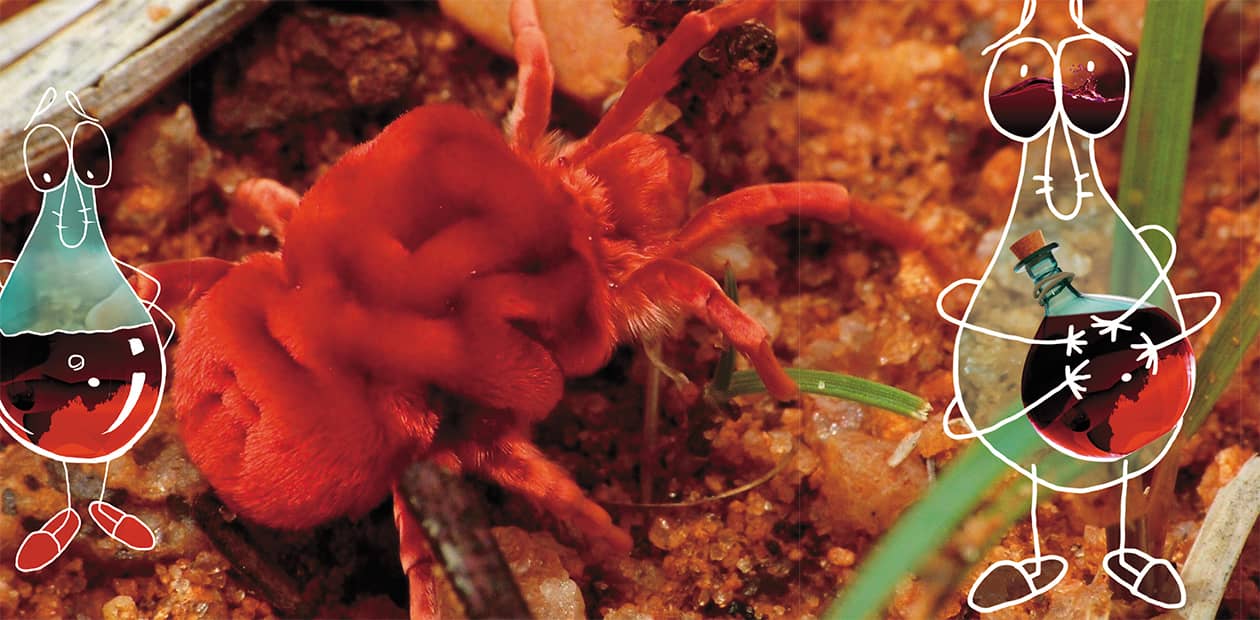Mites and Ticks Are Benevolent Creatures?
What are your first associations with the words “tick” and “mite”? A parasite, a bloodsucker, a bite, an infection... No wonder – ticks and mites trigger only negative emotions in most of us. The well-known parasitic ticks, including ixodids, which carry infectious pathogens dangerous to humans and domestic animals, have undoubtedly earned their dark reputation. However, few people know that these arthropods, which appear so creepy to us, are only a small part of more than fifty thousand species, most of which perform essential functions in natural ecosystems and some – even directly benefit humans! So who are they, our enemies and neighbors? Why are they needed in nature and in the garden, and how can we make a good thing even of blood-sucking parasitic ticks?
Mites and ticks, the most numerous group within the class of arachnids, differ from insects in the number of legs – adult mites and ticks have four pairs of legs, not three. However, it is not always possible to see those legs, as well as their carriers, with the naked eye – the body sizes of most of these creatures lie in the range from hundreds of microns to a millimeter.
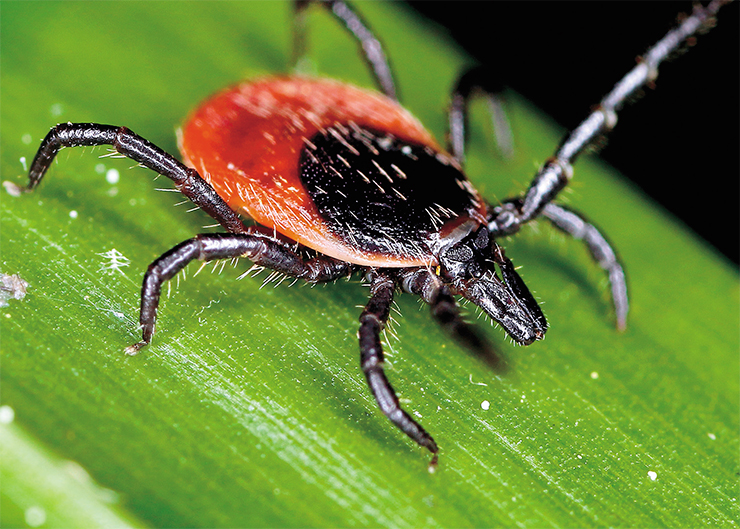
Scientists know of more than 54 000 mite and tick species, which differ in their sizes and colors as well as lifestyles and habitats. Mites and ticks live everywhere: in Arctic ice sheets and in deserts; in bird nests, in animal burrows, and in human homes; they occur even under the skin and in the respiratory system of higher animals. The majority of mites are saprophages, feeding on dead organic matter (from plant residues in the soil to secretions from mammalian auricles), and predators, preying on mites of other species or on small insects. But there also are blood-sucking parasites and plant parasites, feeding on plant sap; it is these latter mites and ticks that attract most attention.
Parasites, bloodsuckers, and marauders
Among mites and ticks, the most notorious parasites that plague the life of humans and domestic animals are the bloodsucking ixodid ticks, which also act as carriers of pathogens of some dangerous infections such as Lyme disease and tick-borne encephalitis.
However, humans and domestic animals can also be attacked by another widespread species, red velvet mites, or more specifically their larvae. The adult specimens are soil predators, feeding mainly on small invertebrates and their eggs, but the larvae can feed on a wide range of vertebrates, sucking in near the auricles, armpits, etc. Their bites are not harmless as thrombidiasis, an inflammatory skin disease, can develop at the bite site; moreover, the larvae of red velvet mites may carry the pathogens of Tsutsugamushi fever, also called scrub typhus.
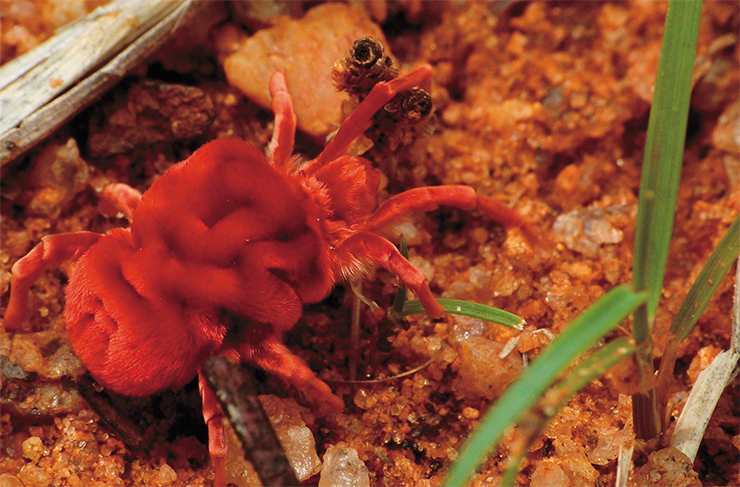
Mites and ticks (Acari) together form a separate, most numerous subclass of the arachnid class. These arthropods are divided, according to one of the classifications, into three superorders:
• Parasitiform mites and ticks, which include not only blood-sucking parasites but also predators and saprophages. Some of them, especially ixodid ticks and gamasid mites, carry pathogens of several dangerous infections.
• Acariform mites, the most numerous group (more than 30 000 species), which includes vertebrate parasites feeding on dead skin and hair as well as plant parasites and granary pests. These mites can also carry infectious agents.
• Mites of the family Opilioacaridae, a small group of large-sized mites that live in the tropics and subtropics, which includes no parasitic species
In Russia, cases still occur of scabies, a disease caused by the microscopic mites Sarcoptes scabiei, also aptly called itch mites. Females of these blood-sucking parasites gnaw tunnels in the near-surface skin layer, where they lay their eggs. While scabies is generally viewed as a disease of the past, it still widely occurs in poor countries.
Some species of ticks and mites cause considerable harm to farm animals. Specifically, a big concern in poultry farming has now come from mites that settle directly in poultry houses. Several species of microscopic mites constantly live on birds, feeding on skin secretions and exfoliated cells of the epidermis.
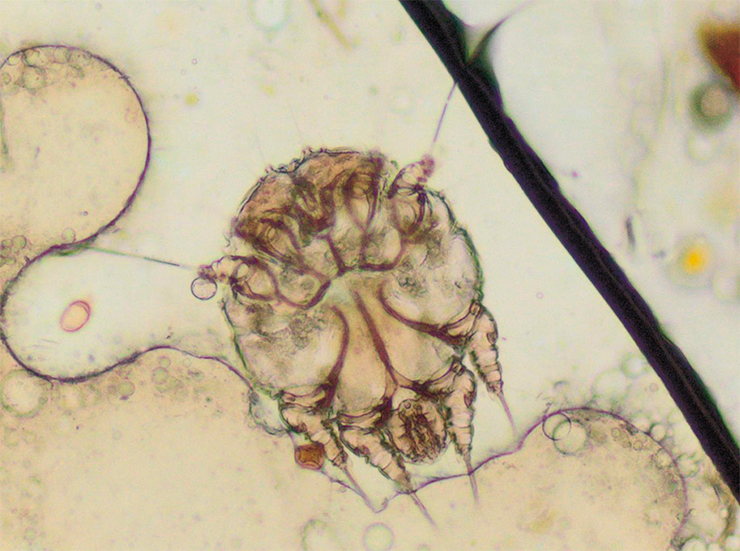
For example, the poultry red mite (Dermanyssus gallinae), a mite of the cohort Gamasides, is almost ubiquitous in Russia. The bites of this blood-sucking parasite, capable of crawling into the ear canal, larynx, and trachea, disrupt not only the skin functions but also those of the respiratory tract; infestation with a large number of these mites may cause exsanguination or even death in birds. Poultry red mites also do harm to poultry farm personnel as they cause dermatitis and damage to ears and eyes. In addition, these mites can carry pathogens such as salmonellas, spirochetes, and rickettsias.
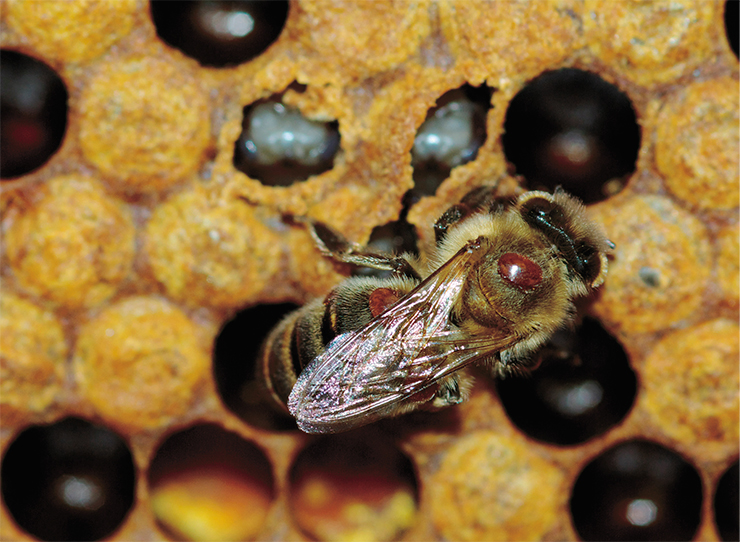
Gamasid mites of the genus Varroa are the cause of the most widespread and dangerous parasitic disease in honey bees: Varroa destructor in European bees and Varroa jacobsoni in the Central Indian bee. These mites are able to firmly adhere to the bee’s body, and the insects carry them to new places, thus infecting other bee colonies
In addition to gamasids, other mites, including those of the cohort Sarcoptiformes, can also parasitize birds. Some of them cause a chronic inflammatory skin disease that resembles scabies; others cause Epidermoptosis, which leads to the falling out of feathers. Moreover, airsac mites affect the respiratory tract, which may sometimes be fatal.
Some species of these gamasid mites cause a most widespread and dangerous parasitic disease in honey bees. Females of mites of the genus Varroa lay their eggs in the honeycomb, which leads to the death of the insects or the birth of weaklings. Adult mites parasitize on worker bees, gorging on their fat body, an analogue of the liver, which is fatal for the host. In addition, these mites serve as vectors of a virus that causes wing deformation in bees. In the 1960s, these mites, which had arrived from East Asia, caused a pandemic in wild and domestic honey bees, resulting in huge economic losses due to the demise of bee colonies and a decrease in the yield of bee-pollinated plants.
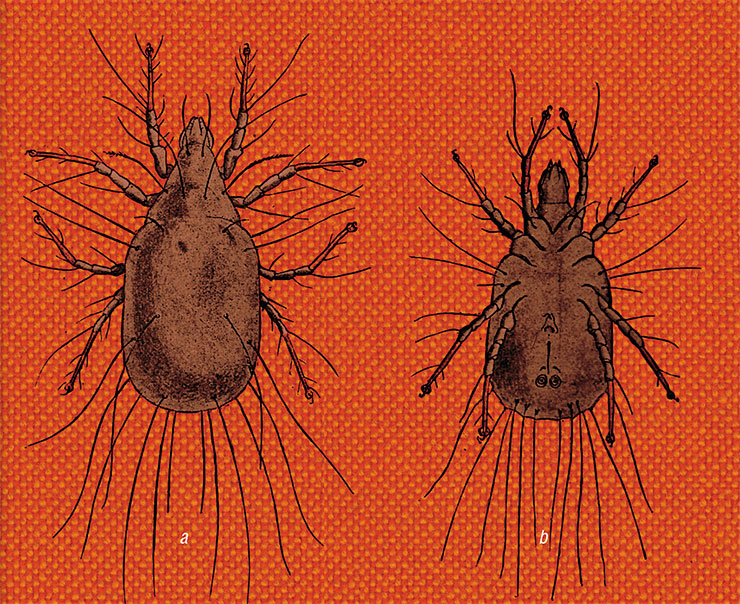
But mites are dangerous not only to birds, animals, and humans – forest plants, houseplants, and agricultural crops, too, fall prey to parasitic mites. Not parasitizing directly on humans and animals, some mites can do great harm by destroying our food and seed supplies. Grain, flour, cereals, bread products, dried fruits, cheeses – all these products can be ruined by Tyrophagus mites of the family Acaridae, which are often called flour mites or cheese mites.
Mites living on birds have long been suspected of bloodthirstiness. However, a recent study conducted on representatives of hundreds of bird mite genera (both from collections and those freshly captured) discovered that their digestive tract contains mainly fungi and bacteria pathogenic for birds rather than bird blood, contrary to the expectations. So, these mites may turn out to be janitors rather than parasites, a clean-up crew for bird feathers (Doña, Proctor, Serrano et al., 2019)
Tyrophagus mites occur virtually everywhere: in the fields and in human homes; in domestic dust and in storage buildings; in agricultural and food products processing facilities; in greenhouses and on mushroom plantations. Breeding rapidly, these mites damage foods, turning them into dust mixed with feces, larval chitinous skins, and remains of dead mites. These substances are strong allergens capable of causing skin irritations and damaging the digestive, respiration, and genitourinary systems in humans.
The tiniest house dust mites – permanent inhabitants of human homes – show no bloodthirstiness either. They feed on dead, exfoliated bits of skin; however, particles of their chitinous shells and waste products can cause severe allergic diseases, including asthma.
We could give more examples of harmful and dangerous species of our eight-legged neighbors; however, even taken all together, these “enemies” make up only a small part of the huge tribe composed of mites and ticks. All the rest are invisible yet crucial members of living natural communities, helping them thrive. Moreover, the mankind has managed to put to its service some of these ticks and mites, including “harmful” ones.
Mites against other mites
A big challenge in agriculture, primarily in glasshouse cultivation, comes from spider mites, which feed on plant cell sap. When these parasites reproduce massively, they can completely destroy crops.

Among these mites, there are species with certain nutritional preferences, as is evident from their names: the hawthorn spider mite and the date palm mite. And, for example, the red spider mite often infests houseplants, including exotic ones such as calla lilies and orchids.
The most widely known pest, however, is the two-spotted spider mite (Tetranychus urticae), a remarkably omnivorous parasite. This mite is able to feed on more than two hundred different plant species of different families: from cotton and potatoes to raspberries and strawberries, from cucumbers and tomatoes to beans and dill, to say nothing about the numerous wild plants. The two-spotted spider mite torments glasshouse flowers and ornamental plants, such as rose, chrysanthemum, etc.
It is this mite species that most often occurs in greenhouses. The mite feeds and breeds on the underside of the host’s leaf. Its paired stilettos, which can fold to form a hollow tube, penetrate deeply into the plant tissue and destroy integumentary and underlying cells. In just five minutes, the mite can pierce and suck out the contents of about a hundred cells.
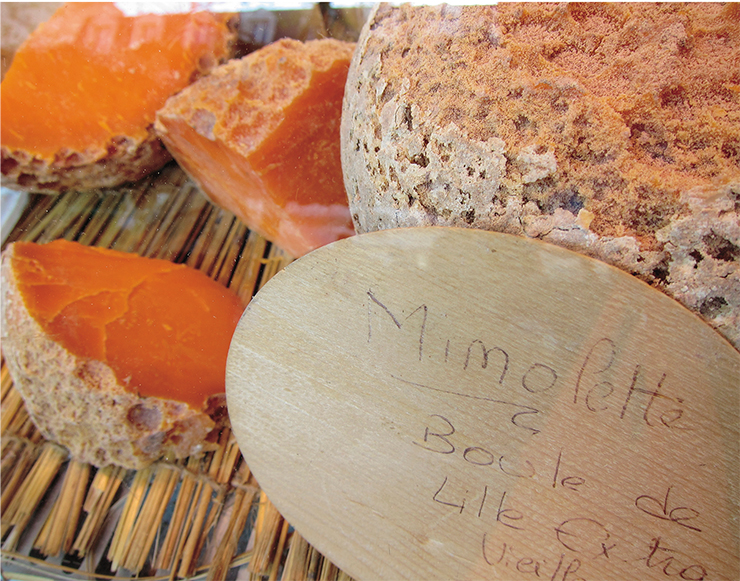
IN THE SERVICE OF CHEESE-MAKERS
In France and Germany, some species of cheese mites have long served to produce special varieties of cheeses. This technology appeared by accident, when cheese-makers had noticed that long-stored cheeses affected by mites acquired an unusual piquant taste and smell, which gained the fancy of many gourmets.
As early as in the 17th century, French cheese-makers began, upon a request from their king Louis XIV, the production of the “mite cheese” mimolette. This cheese is also said to have been a favorite of President Charles de Gaulle, who was born in the city of Lille, around which mimolette cheese is still manufactured today. It is made from cow’s milk, colored orange with a natural dye, and then put to ripen. To this end, cheese-makers place Tyrophagus siro mites onto cheese heads, and the mites “work” on them from several weeks to two years. They gnaw passages in the cheese crust, and their waste products, including excrement and discarded chitinous membranes, imbue the product, as cheese-lovers say, with a hazelnut flavor and a fruity (lemon) aroma.
Before selling, manufactures brush off the mites from mimolette cheese, but some of them remain. In 2013, the United States banned the import of this cheese as “putrid food infested with mites.” But later cheese lovers won and the ban was lifted.
For nearly three centuries, cheese with mites has also been produced in the village of Würchwitz (near the city of Zeitz) in eastern Germany. The Würchwitz Milbenkäse matures in wooden crates inhabited by millions of Tyrolichus casei mites, which are additionally fed with rye flour. As a result, the cheese mass acquires a bitter aftertaste and ammonia aroma, appreciated by gourmets. People eat this cheese together with the live mites it contains. The attitude of the local people toward their unique product is evidenced by the world’s only monument in the honor of the cheese mite, which stands in their village
This damage disrupts the functions of the leaf stomata, where gas exchange occurs; inhibits photosynthesis; and interferes with the sugar outflow. The metabolic disorders suppress the plants, leading to a considerable decrease in their productivity or, given a high quantity of the parasites, to their death.
To combat spider mites, plants are usually treated with various synthetic acaricides. However, repeated treatments lead to the rapid emergence of resistant pest races. Fortunately, an unexpected alternative to synthetic poisons has come from predatory mites that prey not only on insects but also on their eight-legged kin.
Among all the mites capable of killing the larvae and adults of spider mites, the most effective solution comes from representatives of the predatory family Phytoseiidae, which comprises about a third of all the gamasid mites.

The Entomoacariphage Breeding Laboratory of Novosibirsk State Agrarian University (NSAU) is now experimenting with the most promising plant protector – the mite Phytoseiulus persimiilis. This hunter mite finds its prey, i. e., spider mite eggs, larvae, and adults, by the presence of cobwebs on the surface of the leaves. Its malleable morphological structures – the long dorsal setae and the pretarsi (the last leg segments with a pad and claw) – allow it to slide easily between the stretched web threads without getting caught. The mouth apparatus of Phytoseiulus mites is well adapted to eating the food of its choosing – once it finds a spider mite, it cuts through its cuticle with its cheliceral pincers and plunges its head into the opening, sucking out the contents.
At a temperature of 22–24 °C and a relative humidity of 45–55 %, one generation of the two-spotted spider mite develops in 10–16 days, and at 28–32 °C, as fast as in 8–10 days. At first, the lesions look like light-colored dots – these are pricks, which are clearly seen from the upper side of the leaf. Then the leaves become marble-like, turn yellow and die off. The appearance of a fine gray web on the leaves and other mite-damaged parts of the plant indicates a high number of the pest mites and their migration to neighboring plants
First discovered on herbaceous plants in Algeria and Chile, Phytoseiulus persimiilis has spread as a bioprotection agent to greenhouses around the world. In indoor conditions, this predatory mite can effectively control the population of the two-spotted spider mite. The NSAU lab, which maintains the breeding of Phytoseiulus mites year-round, has successfully designed a biotechnology for the protection of cucumbers, tomatoes, and flowering plants such as asters and calla lilies. If this predator mite is preventively released into greenhouses on a periodic basis (it breeds there successfully), there is no need to use chemicals to curtail the growth of the spider mite population.
Researchers at NSAU study several other representatives of the Phytoseiidae family, which also play an important role in controlling agricultural pests. For example, the predatory mite Amblyseius cucumeris is used to eliminate various species of thrips (small insects that often parasitize vegetables and flowers in indoor conditions) as well as the spider mite, the cyclamen mite, and the broad mite. Given a lack of prey, this mite feeds on pollen without harming the plants. Another predatory mite, a native of the eastern Mediterranean, Amblyseius swirskii, has become world famous as a biological weapon against such a dangerous quarantine pest as the whitefly. This mite helps protect various greenhouse and field vegetables, ornamental plants, and citrus fruits.
Saliva: three in one
Over a long time of evolution, ticks have developed several mechanisms enabling them to firmly attach to their victims, anesthetize the bite site, and block the body’s defenses. To solve these problems, tick saliva contains a large arsenal of specialized biomolecules.
The primary one is a unique product of ixodid ticks’ salivary glands, which allows them to stay literally glued to the victim’s skin for days. This tick cement is essentially a mixture of protein, carbohydrate, and lipid molecules. Initially liquid, it hardens quickly to ensure adhesion and prevent the victim’s immune response. The detailed chemical processes that occur in the cement substance during hardening are so far little understood. After feeding, the tick dissolves the cement with special enzymes and falls off.
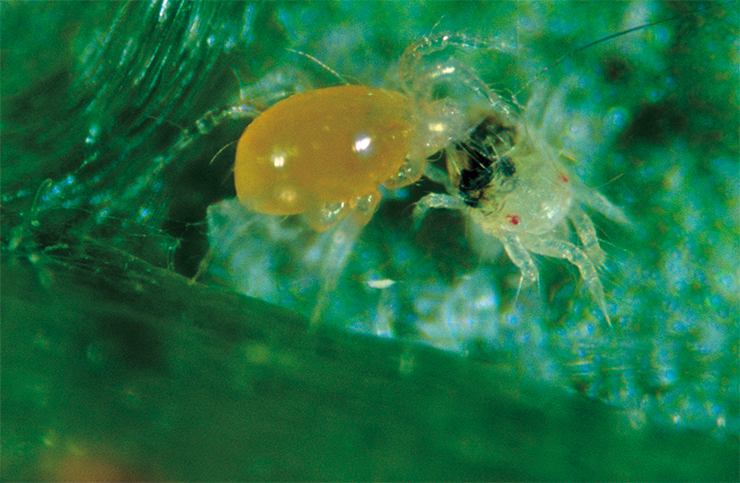
Being a tropical species, the predatory mite Phytoseiulus persimilis has no diapause in its life cycle, remaining active throughout the year. Spider mites become prey not only to adult phytoseiuluses but also to their “adolescent” nymphs. The mites are highly voracious – under optimal conditions, one female can gorge up to 24 mobile phytophage pest mites or 30 of its eggs every single day
Bioglue with properties of the tick cement, i. e., nontoxic and provoking neither allergies nor inflammation and, if necessary, soluble by mild impact, could be a solution for a multitude of issues in medicine, primarily in surgery. After all, modern medical glues either contain toxic substances (cyanoacrylate) or cannot provide strong enough adhesion (fibrin glue).
Such an adhesive would be very useful for minimally invasive surgical interventions since dressing is difficult when manipulating through small incisions. The tick glue is rather viscous, so it could be used to fasten bone fragments, including small ones, which cannot be joined together with screws. Another potential application of the glue is to securely attach intravenous catheters and cutaneous cannulas.
If we understand the mechanisms that underlie the hardening and dissolution of this glue, we could create synthetic products with similar properties, which we could modify depending on the task. Through this kind of engineering, researchers have successfully designed an extra strong adhesive based on the substance with which molluscs attach to the substrate.
When a tick bites a victim, the damage of the skin triggers a response in the victim’s body, i. e., biochemical processes that prevent blood loss and innate immunity reactions creating inflammation at the bite site and healing the wound. These protection mechanisms are very effective and are duplicated for reliability. However, ticks have learned to block every one of them with hundreds of specific saliva proteins injected into the wound.
All these proteins, which very selectively influence the most crucial processes in the body, are real treasures for pharmacists. Dozens of tick salivary proteins are of great interest as potential therapeutics, i. e., as anti-inflammatory, anticoagulanting, and immunomodulatory agents.
To feed themselves, ticks suppress the hemostatic system mechanisms by means of the various substances in their saliva. They disarm the vasoconstrictor system with derivatives of arachidonic acid and prostaglandins. These compounds activate enzymes that contribute to the production of substances with a relaxing effect on the muscles.
Tick saliva contains several different proteins that inhibit platelet aggregation and thrombus formation. These are, e. g., apyrase enzymes, which inactivate the potent platelet activators such as ATP and ADP. Tick saliva also contains inhibitors of proteins that are part of the blood coagulation factor system as well as enzymes that contribute to the destruction of thrombin, a key participant in the blood coagulation process.
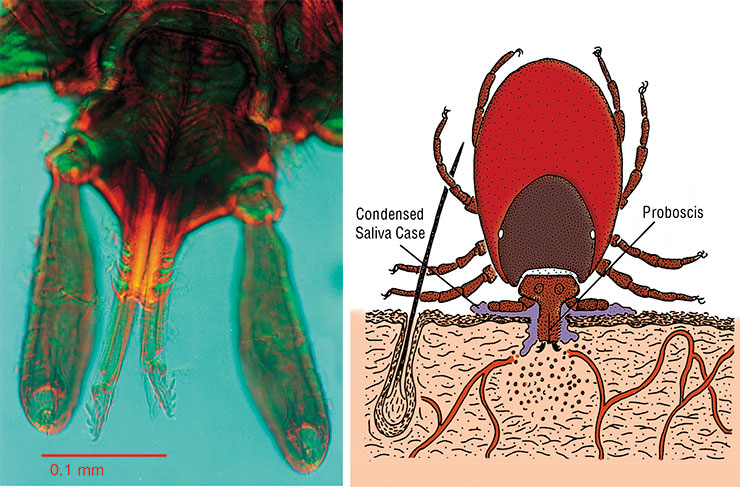
Simply put, the events at a tick bite site are as follows. The first reaction of the body’s hemostasis system is a spasm, i. e., a decrease in the vessel lumen to prevent blood loss. Then, platelets clump together on the exposed collagen fibers of the vascular walls, forming a clot that seals the vessel lumen. Then a strong structure of fibrin protein fibers forms around the clot. This protein is synthesized from the fibrinogen protein under the action of the thrombin enzyme. The latter also participates in other physiological processes such as inflammation.
The platelets of the clot secrete protein factors that stimulate the restoration of the damaged tissue through cell proliferation. After the restoration of the vessel walls, the thrombus is dissolved by special enzymes, i. e., fibrinolysis occurs
Scientists researchers have isolated from the saliva of Ixodes ricinus ticks the Ir-CPI protein, which specifically inhibits two blood coagulation factors: XIIa and XIa. Animal experiments have shown that this tick protein can be used in complex cardiac surgeries involving the application of catheters and arteriovenous bypass grafting. It is known that thrombi are often formed when blood comes into contact with the polymer walls of the tubes, and the popular anticoagulant heparin helps to avoid that. However, this drug largely increases the risk of dangerous bleeding, unlike the ixodid Ir-CPI.
Several enzymes in the tick saliva can directly destroy fibrin clots (e. g., metalloprotease enzymes) and the fibrin precursor itself, i. e., fibrinogen (e. g., longstatin from the tick Haemaphysalis longicornis). In addition, ticks can use their proteins to interfere with the regulation of fibrinolysis in the host’s body, forcing it to dissolve the thrombus by means of its own enzymes.
Regulate immunity
Our immunity protects us by helping to maintain a stable inner environment in the body; however, it can also become a turncoat, as evidenced by autoimmune diseases. Methods of combating unwanted immune reactions and inflammation can also be borrowed from ticks, which need to suppress their victims’ defenses.
One of the best-understood tick salivary proteins that affect the immune response is Salp15. Binding to T-lymphocytes carrying CD 4 receptors on their surface, or T-helper cells, this protein suppresses the activation and proliferation of these immune cells. Experiments on laboratory animals have shown that Salp15 has a long-term immunosuppressive effect; therefore, it is considered a candidate drug for the treatment of diseases arising from abnormal activation of T-helpers: allergic bronchial asthma; systemic lupus erythematosus; and graft-versus-host diseases, which often develop after tissue and organ transplantation.
There is more to come – the CD 4 receptor on the surface of T-helper cells is that very receptor to which the human immunodeficiency virus (HIV) can bind. Consequently, this tick salivary protein can compete with HIV 1 for this receptor, protecting human cells from infection. The study of the Salp15–CD 4 complex may allow the development of drugs that prevent infection with the pathogen of AIDS.
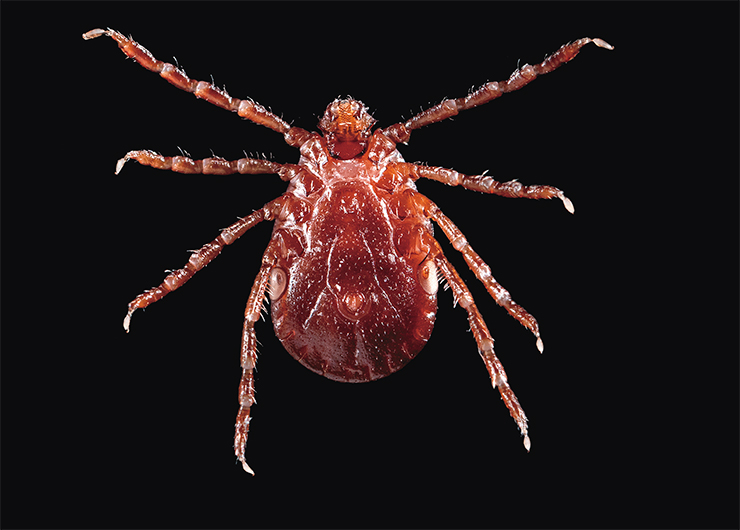
Another group of tick salivary proteins that inhibit the immune response is evasins. Tissue damage (including by a bite) is known to cause a release of chemokine proteins that interact with leukocyte surface receptors, stimulating the latter to migrate to the injury site. This process plays a key role in the inflammatory response. By binding to chemokines, evasins block their attachment to leukocytes. This way they suppress the development of inflammation, and the tick can long feed on the victim and remain unnoticed.
Here we should stress that so far, no effective methods have been developed for combating pathological inflammations on the basis of chemokine blocking. This is due in no small part to the fact that several different chemokines are involved in the complicated process of leukocyte activation. Therefore, different pathological conditions require drugs that either target specific chemokines or impact all of them simultaneously. However, each of the tick salivary evasins has its own set of target proteins with varying degrees of specificity. This is exactly what therapists need, as confirmed by experiments on laboratory animal lines that serve as models of human diseases.
For example, the tick protein evasin 1 was shown to suppress inflammation by acting on neutrophils and T-lymphocytes, on macrophage migration, and on the synthesis of inflammatory cytokines. This protein is promising for the treatment of pulmonary fibrosis and adverse consequences of transplantation. Evasin 4, which interacts with more than 18 chemokines and inhibits the activation of eosinophils, is of interest as a drug for the prevention of myocardial damage after a heart attack.
Still another protein, evasin 3, suppresses neutrophil-mediated inflammation, thus preventing the development of ischemic stroke and acute pancreatitis. It is also proposed to use this protein labeled with a fluorescent dye to diagnose problem areas of vessels with atherosclerotic plaques, since it is these areas that hold a concentration of specific cytokines to which evasin 3 can bind.
Special attention also focuses on the multifunctional tick salivary proteins lipocaines. These proteins bind the biogenic amines serotonin and histamine, which affect platelet adhesion and vasoconstriction; moreover, histamine also mediates inflammation and increases the permeability of vascular walls. Blocking these amines by means of tick proteins prevents the formation of blood clots and stops the development of inflammation and immune response. Tick lipocaines also modulate dendritic cell differentiation by influencing the T-lymphocyte-dependent cellular immune response.
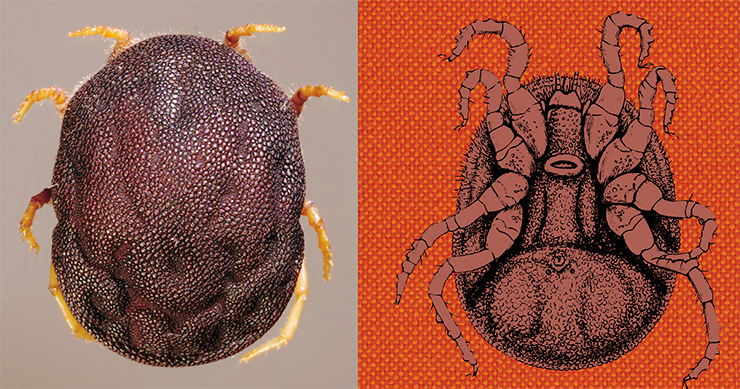
Lipocaine from the saliva of an argasid tick Ornithodoros moubata is already undergoing clinical trials as a drug for the treatment of thrombotic microangiopathy (pathological damage to small blood vessels). And several lipocaines have been successfully tested in animal models of diseases accompanied by high histamine levels, such as asthma.
TICKS AGAINST CORONAVIRUS
It is known that one of the main factors causing in patients with COVID 19 a severe form of the disease up to death is the so-called cytokine storm, i. e., a release of large amounts of pro-inflammatory cytokines due to an excessive response of the immune system to infection. The patient’s innate immune system attacks the lungs, disrupting their functions, as a result of which the person cannot get the necessary amount of oxygen.
In the spring of 2020, the British company ILC Therapeutics LTD, which specializes in the development of immune system therapeutics, announced a promising new drug for the treatment of lung lesions caused by the new coronavirus infection. The drug, essentially a cocktail of three evasins (tick salivary proteins), proved capable of suppressing lung inflammation even in severely ill patients.
In the summer of 2020, the biopharmaceutical company Akari Therapeutics launched in the United States, United Kingdom, and Brazil the third round of clinical trials of the innovative drug nomacopan as a promising drug for coronavirus pneumonia. The drug, essentially a small recombinant protein, is derived from a protein first isolated from the saliva of the African argasid tick Ornithodoros moubata, which prevents inflammation at the bite site. The drug targets several inflammatory responses at once and has proved successful in the treatment of autoimmune diseases. At the end of the year, company representatives reported positive results of the trials of the drug, which can inhibit the release of tissue-damaging cytokines and have anti-inflammatory and anti-thrombotic effects, not only in COVID pneumonia but also in other severe inflammatory lung diseases
Of course, for tick proteins to be used in therapy, technology should be in place for industrial production of either these very proteins or their improved, modified versions. However, modern biotechnologists have all the knowledge and tools to accomplish that.
So, mites and ticks, what kind of animals are they – harmful or benevolent? We, humans, can better see the harm they create. However, as mentioned above, the overwhelming majority of species of these arthropods are predators or scavengers – saprophages. These tiny toilers inhabiting the upper soil layers, the nature’s janitors and ploughers, are an important part of natural ecosystems and cultural biocenoses. And some of them successfully serve humans as bioweapons or biotechnological solutions.
Ecologists argue, however, that the very question of usefulness and harmfulness of certain animals is misleading. Even when asked about the most unpleasant blood-sucking ixodid ticks, like any other parasite, this question remains very complicated, and the answer to it is far from obvious. Mites and ticks have the right to exist, like all the other living creatures that have appeared in the process of evolution.
But more objective arguments are proposed as well. Mites and ticks, including parasitic ones, are part of food chains. Until we understand all the ties that exist in living communities in which mites and ticks are involved, the removal of any link may have completely unpredictable consequences, up to the extinction of species. For example, ixodid ticks are a good meal for birds and frogs, lizards and spiders; one will hardly come across these eight-legged creatures in the vicinity of anthills of red forest ants.
Nonetheless, these arguments are difficult to agree with. The nutritional value of a hungry ixodid tick, which is essentially nothing but a tough chitinous shell, is not so high. Of course, a tick filled with blood is a completely different story – a real gift for a predator. However, they are available in sufficient quantities, perhaps, only to birds in Africa, where ticks parasitize many large ungulates. But even in this case, ticks unlikely constitute the core nutrition for these birds, essential to their existence, whereas many animals would be happy to live without these parasites.
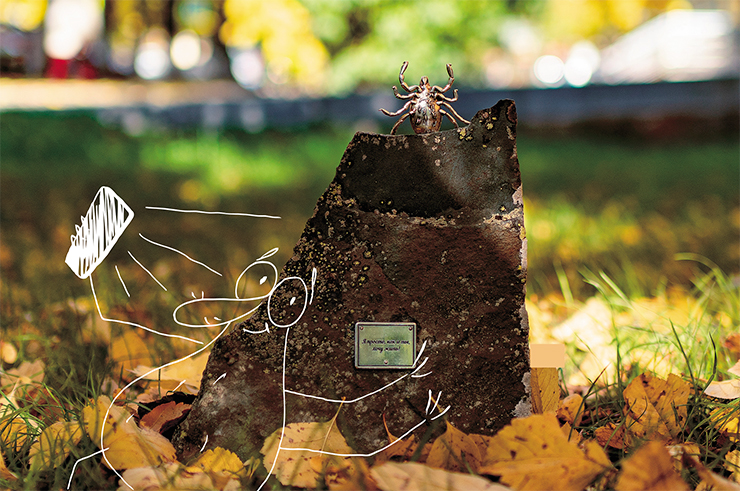
However, ecologists point out yet another aspect of parasitic mites and ticks: they serve as a factor of natural selection, which maintains the natural balance in ecosystems. Blood-sucking ticks (and pathogens carried by them) are dangerous primarily for weakened animals with poorly functioning immune systems. A hypothesis exists that removing them completely from nature will reduce the viability of vertebrate populations due to the uncontrolled reproduction of the latter. As scientists say, “people try to prevent or cure diseases. However, like mites and ticks, diseases play an important role. They make it possible to control animal populations by eliminating weaker specimens, which could have left weak offspring.”
Theoretically, this is true, but today humans and their activities are increasingly becoming the controller of animal populations. Moreover, it is uncomfortable for us to agree with this point of view when it comes to controlling our, human, population. Indeed, today our planet is home to a huge number of people, and many of them, as the current pandemic has clearly shown, are susceptible to diseases. However, none of us wants to perceive diseases, including those carried by ticks, as a factor in maintaining health of the human population.
One way or another, the possibility of complete extermination of the unwanted mites and ticks remains so far only a matter of theoretical speculations. In any case, it would be wise to keep some of them in a “zoo,” as is now done with smallpox viruses. Indeed, the huge set of genomes of parasitic mites and ticks encodes many proteins with different functions, some of which are considered potential therapeutic drugs.
Mites and ticks, even the most dangerous ones, are part of the diversity of life on the Earth. And while they live next to us, we must learn to get along with these neighbors.
References
Vlassov V.V., Rar V.A., Tkachev S.E., and Tikunova N.V. Ticks That Bite Us // SCIENCE First Hand. 2020. V. 54.
N 1. P. 26–45.
Bhusal R. P., Eaton J. R. O., Chowd-hury S. T. et al. Evasins: Tick Salivary Proteins that Inhibit Mammalian Chemokines // Trends in Biochemical Sciences. 2020.
V. 45. N. 2. P. 108–122.
Blisnick A. A., Foulon Th., Bonnet S. I. Protease Inhibitors in Ticks: An Overview of Their Role in Tick Biology and Tick-Borne Pathogen Transmission // Front. Cell. Infect. Microbiol. 2017. 22;7:199
Chmelař J., Kotál J., Kovaříková A. et al. The Use of Tick Salivary Proteins as Novel Therapeutics // Front Physiol. 2019. 26;10:812.
Maritz-Olivier С., Stutzer C., Jongejan F. et al. Tick anti-hemostatics: targets for future vaccines and therapeutics // Trends Parasitol. 2007. V. 23. N. 9. P. 397–407.
Suppan J., Engel B., Marchetti-Deschmann M. et al. Tick attachment cement – reviewing the mysteries of a biological skin plug system // Biol. Rev. 2018. V. 93. P. 1056–1076.


